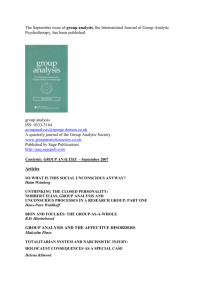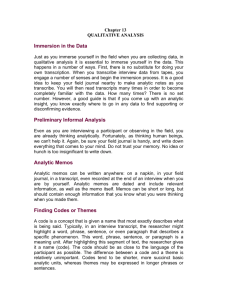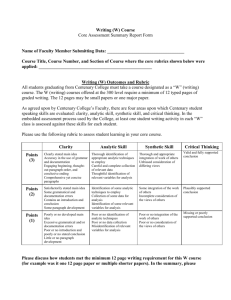Data to Knowledge to Results Rev4
advertisement
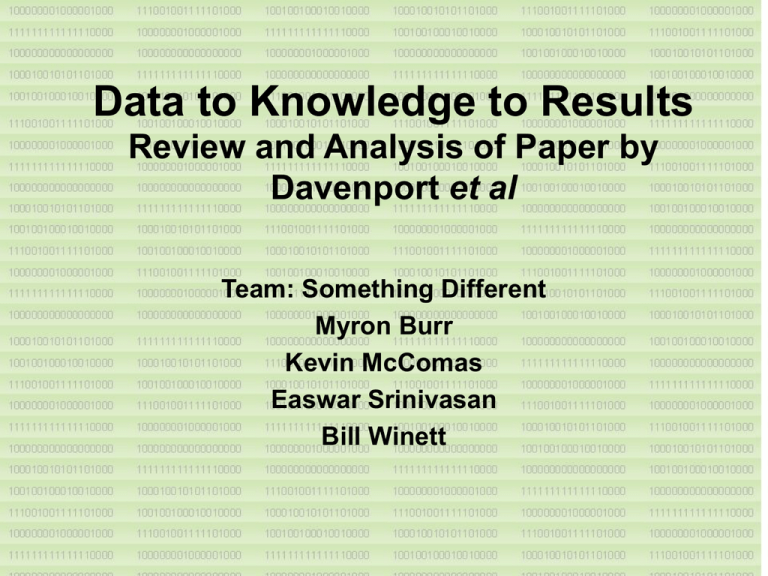
Data to Knowledge to Results Review and Analysis of Paper by Davenport et al Team: Something Different Myron Burr Kevin McComas Easwar Srinivasan Bill Winett Data vs Information Data : Measures, Transactions Knowledge / Information Profit maximizing product mix Parts per hour Billing rate Click through rate Profit maximizing bundling of solutions Individualized, targeted web pages What are the Issues? • Background: – Firms are spending billions on IT applications ( ERP, POS scanners, web and e-commerce systems, and CRM) – Generated billions of transaction records • Observation: – Very little data is converted to knowledge (less than 10% in studied firms) • Problem Statements: – Lost opportunities for improved results – Unrealized business value from these investments Proposed Approach to Resolution Davenport et al, researched over 100 companies Developed a model for building analytic capability Demonstrated how to realize results from this capability Framework Strategy • What are our core business processes? • What key decisions need analytic insights? • What information matters? • Clear strategy leads to good measurements and therefore good data gathering Context Process needs a foundation Required ingredients for success Grounded in Firm’s strategy (and the information needed to execute this strategy) Skills and experience of staff Organization and culture Data-oriented / Fact-based Technology and Data Skills and Experience Key Roles DB Administrator: loads, organizes and checks data Business Analyst / Data Modeler Decision Maker / Outcome Manager Skills: Depth depends on above role Technology Skills Statistical Modeling and Analytic Skills Knowledge of the Data Knowledge of the Business Communication and Partnering Without skilled staff, IT applications are a waste of $$$. Organization and Culture 62% of managers: organization and culture biggest barriers to getting significant return on IT investment Related to skills and experience Value Data-oriented / Fact-based analysis and decision making Organization of analytics staff Centralized or decentralized depends on: Sophistication of the analysis Amount of local knowledge needed Cultural orientation of the firm Technology and Data Specific hardware and software, networking and infrastructure Transaction versus analytic approach Integration of analytic technologies Requires human insight; can’t automate 60 to 80% of cost in cleaning up and integrating data Transformation Data to Knowledge Analytic and Decision Making Process Depends on experience and relationships of analysts and decision makers Working closely with decision makers to understand the questions: Standard, highly-structured: Inventory? Sales? Semi-structured: Optimum inventory level? Production versus forecasting? Unstructured: customer segment migration? An evolving and iterative process Use “decision audits” to evaluate effectiveness of process Outcomes Desired financial outcomes (greater profitability, revenues, or market share) may require changes in: Behaviors: e.g., cost control Processes and Programs: e.g., development of new marketing initiative Extensive communication may be required Implementation of decisions will determine result. Application Methodology • Flowchart High quality transaction data? No Implement new systems and data architectures No Launch small pilots and educate managers No Launch analytical initiative in single area No Launch analytical organizational change program Yes Supportive senior executives? Yes Broad need in organization? Yes Analytical skills and culture in place? Yes Integrate analytical capabilities into business Implementation Options • Business needs to dictate extent of implementation and level of focus Examples Source: http://www.cs.csi.cuny.edu/~imberman/DataMining/KD D%20beginnings.pdf More Results • Earthgrains eliminated 20% of products, increased profits by 70% • Owens & Minor won $100M contract by showing customer how to save money • Wachovia Bank improved performance by modeling branch locations • Harrah’s Entertainment plans to use customer data to increase cross-selling • Fleet Bank saved >$12M encouraging customers to change from branches to ATMs Outcome: Increased Profitability Cumulative Profitability Dependence on Route Complexity 50 Cum. Profit ($Millions) 45 40 35 30 25 20 15 10 5 0 0 5 10 15 20 Number of Routes 25 30 35 40 Other Applications of Data to Knowledge to Results Source: http://www.cs.csi.cuny.edu/~imberman/DataMining/KDD%20beginnings.pdf Take-Aways To get the most from your IT investment: • Hardware, software, networking and infrastructure only the starting point • You need to commit significant skilled human resources • Develop sophisticated analytic processes • Instill culture that values data and creating information • Make decisions on info and then execute Additional Resources • • • • • • • • • • • SAP.com Oracle.com Google Analytics Accenture.com Spotfire.com i2.com Salesforce.com cio.com b-eye-network.com juiceanalytics.com WonderWare.com Questions?

![Mathematics 414 2003–04 Exercises 1 [Due Tuesday October 28th, 2003.]](http://s2.studylib.net/store/data/010415762_1-9e53d350b0430ad1e5431d2ba3c48759-300x300.png)
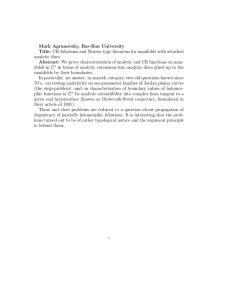

![Mathematics 414 2003–04 Exercises 3 [Due Monday January 5th, 2004.]](http://s2.studylib.net/store/data/010415764_1-3f4084aa6eb8e046b7be83fab4c2a801-300x300.png)


